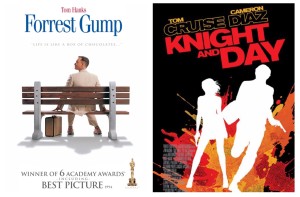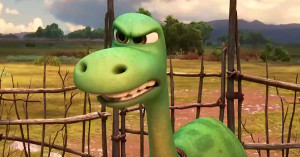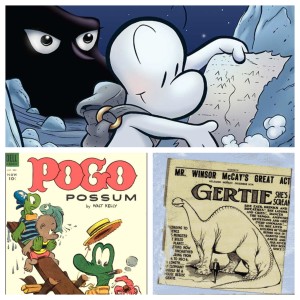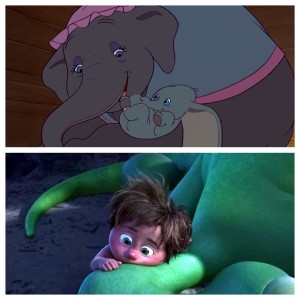Some critics aren’t doing their job in regards to Disney’s new Pixar film The Good Dinosaur. They’re misreading the film and, because of it, may cause audiences to miss a truly heartfelt, cinematic treasure–one of the best kid movie fables in years.
The first step in ‘reading’ a film — i.e. determining the intent or meaning behind the story — is to understand what kind of film it is by 1) using the cinematic language of the film itself to give clues to director intent or 2) referencing outside sources such as interviews that more explicitly reveal the inspiration behind the film.
It is the unfairest burden on a film to treat it as something that it’s not. For example, Forrest Gump was a cinematic fable, it was never meant to be a historical recreation of late 20th century events. So, for someone to attack the historicity of the film, i.e. to say the Vietnam scenes didn’t really happen that way or the timeline of events was incorrect, and to thereby miss the true intent of the film, is an unfortunate misreading of the film. That film was shot to appear realistic but the story was pure fable. And, understood as fable, the over-the-top elements of ‘unconditional love’ and the emotional climax that some critics attacked as ‘sentimental’ make a different kind of sense: an emotional sense rather than a realistic or conventional sense.
Consider the first shot of Knight and Day in relation to its potential meaning. The movie opens on the back of the protagonist’s head (Tom Cruise) as he walks through the airport. Why start an action film on the back of your star’s head (especially when all the advertising prominently features his face) unless you’re trying to tell the audience something? Such as: the proceeding adventure you’re about to see is through the head of, or from the exaggerated perspective of the storyteller (which is not the director in this case but the protagonist) — i.e. he’s going to exaggerate his own prowess and adventures as he takes us (like the Cameron Diaz character) along for the ride. The director is literally placing the audience behind the hero at head level as if to give us a view through his eyes. This makes Knight and Day not unlike a classic film noir narrated by the detective, except with the narration removed, leaving only the visual advancement of the story as the ‘narration’.
And yet, Knight and Day was roundly criticized by critics as being ridiculous, over-the-top, and unbelievable. But, read this way, the first shot suggests it was meant to be — told by an unreliable, partly psychotic, fun-seeking protagonist. Of course he’s going to exaggerate his mannerisms, confidence, skill with weapons, etc. And, of course the girl is going to be knocked out for much of the film. She doesn’t serve ‘his’ telling of ‘his’ remarkable story. She doesn’t help it move from point to point; that’s ‘his’ job.
All of this is preamble to the initial wave of critics misreading Pixar’s new film The Good Dinosaur. This film is not meant to be a realistic, documentary-type portrayal of what might have happened had the dinosaurs evolved over millions of years. And yet, one critic from Forbes criticizes it for exactly that reason: faulty science. Admittedly, the near-photo realism of the movie may be sending a mixed message to audiences. And, the Disney marketing department didn’t do the film a favor by releasing a trailer that posed that very question — what if the meteor that killed the dinosaurs missed? So, the critic shouldn’t be entirely blamed.
Still, a more careful reading of the film might have been expected. For example, if the filmmakers intended the film to be realistic and science-based, why is the character design so cartoonish? Arlo, the lead dinosaur, is so rounded and has such big teeth that one versed in animation history might recall Winsor McCay, Jeff Smith’s Bone series, or even Walt Kelley’s Pogo. Isn’t it likely that by placing obviously cartoonish characters in a photo-real world, the storytellers are giving a clue that they don’t intend this film as documentary?
Another critic attacks the film for not being like Pixar’s other films, specifically for only featuring kids in the main roles and not showcasing its usual adult tag-alongs. It’s a valid insight but an invalid criticism because the film wasn’t intended to be like Pixar’s other films. Another critic blasts the film for being exactly the kind of film director Sohn intended it to be: a kids fable.
In this Variety article reporting on the film’s early showing at a French film festival, Sohn (who’s Korean) relates the powerful experience of watching his mother (who didn’t speak English) process the full emotion of the scene in Dumbo where the mother must say goodbye to her son without a single line of dialogue. That experience has stayed with Peter Sohn all his life and directly inspired a scene from The Good Dinosaur he showed to the French audience.
The inspiration of Dumbo is a crucial factor in reading this film because Dumbo couldn’t be construed by anyone to be a realistic, documentary-type look back at the American circus. It features a flying elephant for goodness sake! Much like The Good Dinosaur, it’s a fable about losing one’s parent and coming-of-age in a new, terrifying and challenging world. And, as a fable, it’s one of early Disney’s best films. It’s also one of Disney’s shortest (another complaint lobbed against The Good Dinosaur) because it’s a model of efficient storytelling: the perfect script. It tells the story it needs to tell, beat by beat, and only the story it needs to tell. Then it ends.
Now, if Disney had marketed The Good Dinosaur as a kids fable in the vein of Dumbo or another non-Disney fable like The Red Balloon, then the critical reaction might have been more in line with the movie delivered by the filmmakers and we might not only be talking about Inside/Out competing in the Oscar race.
This little trip down film criticism aisle is merely an admonition: don’t miss out on this truly wonderful film because of critics reading it for what it isn’t. This isn’t a film about dinosaur biology or alternative evolution. It’s not a cookie-cutter Pixar film that recalls past efforts with substantial adult roles mixed in with child ones. Yes, it has familiar elements and may seem simple but the best fables are. They’re familiar because they appeal to story-pattern recognition in younger minds and because they retread issues and conflicts that have driven stories from the dawn of time. Each generation needs its own fables, told in a technology and style that speaks to them.
Peter Sohn shouldn’t be criticized for delivering an updated homage to Dumbo in dinosaur skin; he should be praised for telling a film so beautiful and emotional that it deserves to stand alongside some of cinema’s best movies for kids.





Good work, Rick. This post make me miss the days when my family frequented children’s movies. Watching films in the company of fresh sensitive viewers can be a profound experience.
We’re all children, of course, though most of us forget over time. Buried beneath layers of critical adult thinking is a memory-center of childlike consciousness. Art can take us to that center if we’re willing to embrace a greater context.
Thanks for your comment, Watt! That might be an interesting film class for Tolovana Arts Colony: watching kids films and using that as an exercise to write and/or talk about our own childhood natures and how adulthood has changed them.
PS I finally watched the film ‘Sometimes a Great Notion.’ Makes me want to buy that Matt Love book in your store window. Can’t wait to talk with you about it. But, oy vey, what a depressing writer! He could very well be the antithesis of narrative art for me!
Great idea for a film class!
Have you read Kesey’s novel? It’s in a whole different league than the movie, though Newman gave it an earnest shot. Both are dark, yes — the book is even more so.
Now that I think about it, there aren’t many children in it. In fact I can’t think of any, except troubling flashbacks to youth for adults in troubling situations. But it’s an excellent read, if you get the chance.
I haven’t read it, Watt. I don’t think I could now. And, no, there are no kids featured in the film, but because of the type of family the lead character had it made me think of my own childhood with similar in-laws. The other ‘kid’ comment was in relation to the Good Dinosaur and other great kid-centric films. Happy Holidays to you and your family! Any movie you’re excited about? I still haven’t seen Spectre!
I haven’t seen Spectre either. In fact I can’t remember the last James Bond movie that I watched. My interest in the studly Brit action-hero started to wane after “Live and Let Die.” (Fun factoid: when I was a lad, during a family trip to New Orleans for a funeral directors’ convention, I danced on the sidewalk with the same jazz-funeral band that’s featured in the beginning of that film.)
Jennifer and I recently rented “The End of the Tour” from Nehalem Bay Video. She loved it as much as I did, even though she’s never read anything by David Foster Wallace. I would be very excited about watching a new James Bond flick if it were suddenly discovered that Wallace had written a secret script. Peace be upon him.
And peace be upon all of us, living and dead. May we humans learn to be less violent during this and every holy season.